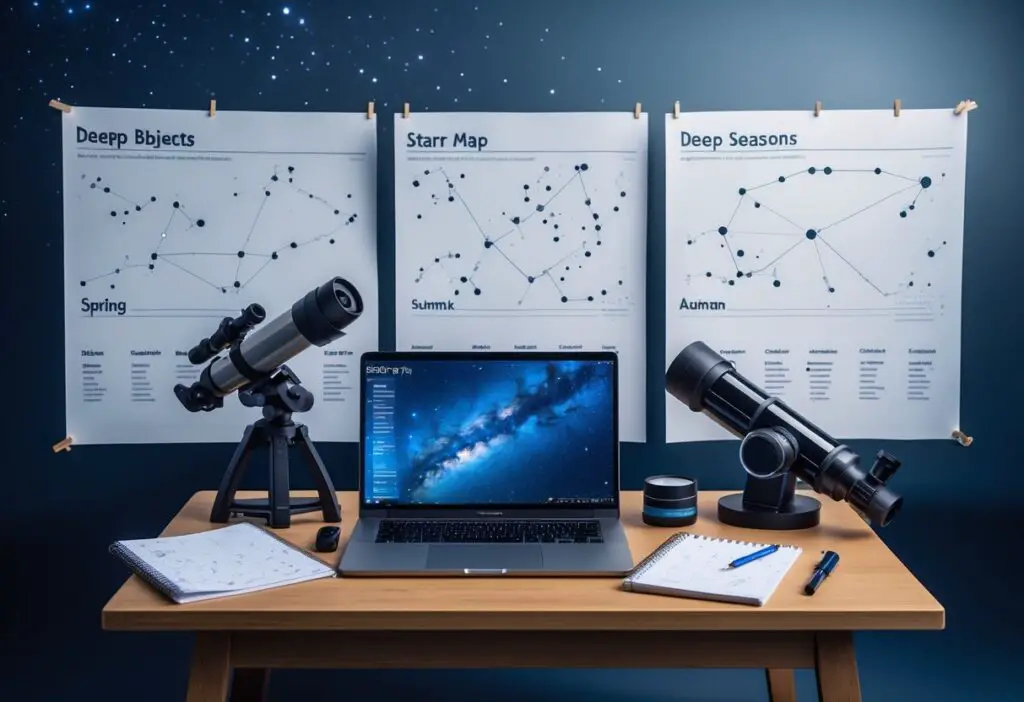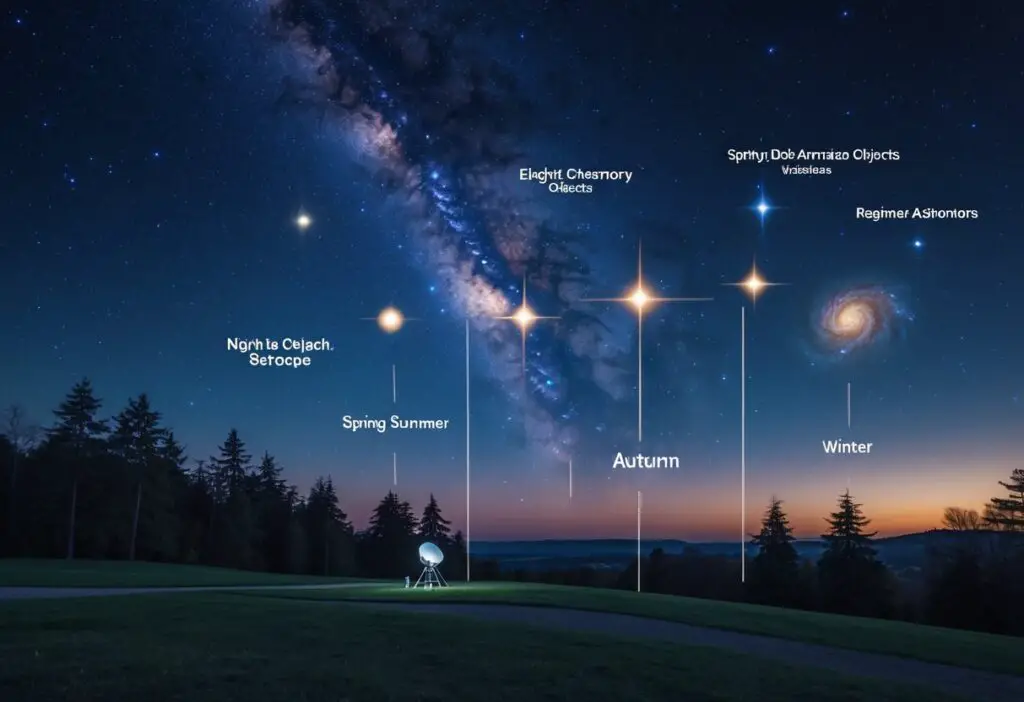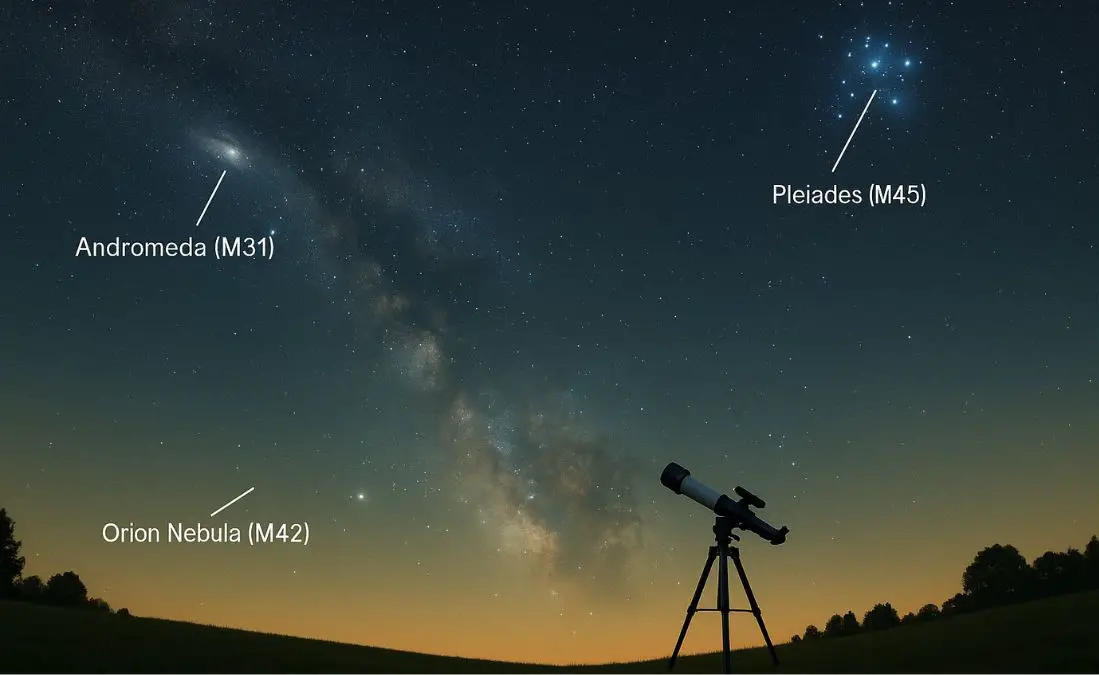Deep sky objects offer beginning astronomers some of the most rewarding viewing experiences, but timing matters significantly when planning observation sessions. The visibility of galaxies, nebulae, and star clusters changes throughout the year as Earth orbits the sun, making certain objects prime targets during specific seasons while others disappear from view.
New observers can successfully locate and enjoy dozens of deep sky objects year-round by understanding which targets are best suited for each season and their current skill level. Spring brings galaxy season with targets like the Whirlpool Galaxy, summer offers bright nebulae such as the Dumbbell Nebula, fall provides excellent viewing of the Andromeda Galaxy, and winter delivers stunning objects like the Orion Nebula.
Many beginners struggle with unrealistic expectations about what they will see through their telescopes compared to colorful space photographs. Understanding the seasonal availability of targets, combined with proper equipment knowledge and realistic viewing expectations, transforms frustrating nights into successful deep sky adventures that build confidence and observational skills over time.
Understanding Deep Sky Objects and Equipment

Deep sky objects require specific equipment and optimal viewing conditions to observe successfully. Beginners need to understand object types, select appropriate equipment, choose dark locations, and time their observations with lunar cycles.
Types of Deep Sky Objects for Beginners
Deep sky objects include any astronomical object outside our solar system. The three main categories are galaxies, nebulae, and star clusters.
Star clusters provide the easiest targets for beginners. Open clusters like the Pleiades (M45) contain young, hot stars loosely bound together. Globular clusters such as M13 in Hercules appear as dense, spherical collections of older stars.
Nebulae come in several forms that beginners can observe. Emission nebulae like the Orion Nebula (M42) glow red from excited hydrogen gas. Reflection nebulae appear blue as starlight reflects off dust particles.
Galaxies represent the most challenging category for new observers. Spiral galaxies like the Whirlpool Galaxy (M51) show distinctive arm structures. Edge-on galaxies such as the Needle Galaxy (NGC 4565) appear as thin lines with dark dust lanes.
Bright nebulae and open star clusters offer the most rewarding first experiences. These objects remain visible even under modest light pollution and through small telescopes.
Recommended Binoculars and Small Telescopes
Binoculars provide an excellent starting point for deep sky observation. 7×50 or 10×50 models offer the best combination of magnification and light-gathering power for beginners.
Best DSO for binoculars include the Pleiades, Beehive Cluster (M44), and Double Cluster in Perseus. The Orion Nebula appears as a fuzzy patch even in modest binoculars. Large nebulae like the California Nebula become visible under dark skies.
Small refractor telescopes between 80-102mm aperture reveal significantly more detail. Small telescope targets for beginners include the Ring Nebula (M57), globular clusters like M13, and bright galaxies such as M31 Andromeda.
| Equipment | Aperture | Best Targets |
|---|---|---|
| 7×50 Binoculars | 50mm | Large clusters, bright nebulae |
| 10×50 Binoculars | 50mm | Star clusters, double stars |
| 80mm Refractor | 80mm | Nebulae, galaxies, clusters |
| 6″ Reflector | 150mm | Faint galaxies, planetary nebulae |
Telescopes with focal ratios between f/5 to f/7 work well for deep sky objects. Faster focal ratios gather more light but may require precise collimation.
Choosing Stargazing Locations Based on Bortle Class
The Bortle Scale measures light pollution from Class 1 (pristine dark skies) to Class 9 (inner city). Each class determines which deep sky objects remain visible to observers.
Bortle Class 4-5 locations represent suburban areas where many bright deep sky objects stay visible. The Orion Nebula, Pleiades, and brighter galaxies like M31 appear clearly through telescopes.
Bortle Class 6-7 areas suffer from moderate to severe light pollution. Only the brightest nebulae and star clusters remain observable. Light pollution filters can help enhance nebula contrast.
Bortle Class 1-3 sites offer excellent conditions for faint galaxies and nebulae. The Milky Way appears prominent, and hundreds of deep sky objects become accessible to small telescopes.
Urban observers should focus on bright targets like M42, M45, and M13. A drive to Class 4 skies opens up galaxy observation and reveals fainter nebular details.
Importance of Moon Phase Planning
Moon phase planning determines observation success for faint deep sky objects. The lunar cycle directly affects sky darkness and target visibility.
New moon periods provide the darkest skies for observing galaxies and faint nebulae. The week around new moon offers optimal conditions for challenging targets like the Leo Triplet or faint emission nebulae.
First and third quarter moons rise around midnight or set before midnight. These phases allow several hours of dark sky observation either early evening or before dawn.
Full moon washes out faint objects completely but enhances double star observation. Bright targets like the Orion Nebula remain visible even during full moon periods.
Plan galaxy hunting sessions during new moon phases. Save bright nebulae and star clusters for times when moonlight affects sky conditions. Track lunar rise and set times to maximize dark sky hours.
Spring Deep Sky Objects for New Observers

Spring offers newcomers to astronomy an excellent collection of bright galaxies and accessible nebulae that are perfect for developing observational skills. The season provides optimal viewing conditions for galaxy clusters in Virgo and Leo, along with several prominent star clusters and nebulae visible through small telescopes and binoculars.
Here is a book that is simple (words and pictures) to comprehend if you are just starting out, it may help? If you want to check it out on Amazon, Click Here
Top Spring Seasonal Stargazing Targets
M44 (Beehive Cluster) stands out as the premier spring target for beginners. Located in Cancer, this open star cluster appears as a hazy patch to the naked eye and resolves into dozens of individual stars through binoculars.
M81 and M82 in Ursa Major form a stunning galaxy pair. M81 shows a bright spiral structure while M82 displays an edge-on cigar shape. Both galaxies fit within the same low-power telescope field of view.
The Leo Triplet consists of M65, M66, and NGC 3628. These three galaxies cluster together in the constellation Leo and provide an excellent introduction to galaxy hunting.
M13 in Hercules begins rising in late spring. This globular cluster ranks among the brightest in the northern sky and shows impressive detail through modest telescopes.
M3 offers another excellent globular cluster target. Found in Canes Venatici, it provides easier location than M13 for spring observers.
Best Nebulae and Galaxies Visible in Spring
M51 (Whirlpool Galaxy) presents clear spiral arms through 6-inch telescopes. Located in Canes Venatici, this galaxy demonstrates classic spiral structure better than most other targets.
M104 (Sombrero Galaxy) displays a distinctive dark lane across its bright nucleus. Spring positioning makes this Virgo galaxy accessible to observers throughout the night.
The Virgo Galaxy Cluster contains dozens of bright galaxies within a small sky area. M87, M84, M86, and M49 provide excellent starting points for galaxy cluster exploration.
M97 (Owl Nebula) represents the best planetary nebula for spring viewing. Located in Ursa Major, it shows a distinctive owl-like appearance through larger telescopes.
NGC 2903 in Leo offers bright spiral structure often overlooked by beginners. This galaxy provides excellent detail through small telescopes and rewards careful observation.
Beginner Binocular-Friendly Spring DSOs
M44 delivers the best binocular experience among spring targets. Standard 7×50 or 10×50 binoculars resolve individual cluster stars clearly.
M81 and M82 appear as fuzzy patches through binoculars. While detail remains limited, both galaxies show obvious non-stellar appearance that distinguishes them from background stars.
M67 in Cancer provides another accessible open cluster. This older cluster contains fewer bright stars than M44 but remains easily visible through binoculars.
Mel 111 (Coma Star Cluster) spans several degrees of sky. Binoculars show this loose collection of stars better than telescopes due to the wide field requirements.
M3 becomes visible through larger binoculars as a hazy star. While individual stars remain unresolved, the cluster’s brightness makes it detectable through 10×50 binoculars from dark sites.
Summer and Fall Deep Sky Objects for Beginners
Summer and fall offer some of the most spectacular deep sky objects for beginning astronomers, with bright emission nebulae dominating summer skies and distant galaxies becoming prominent in autumn. These seasons provide excellent opportunities for both visual observation and astrophotography with basic equipment.

Seasonal Favorites in Summer Skies
The summer months present the most beginner-friendly deep sky objects visible from the Northern Hemisphere. The Lagoon Nebula (M8) stands out as an exceptional target, visible even with the naked eye under dark skies at magnitude 6.0.
Located in Sagittarius, observers can find M8 by locating the distinctive teapot asterism and moving upward from the handle’s top left star. This emission nebula responds well to small telescopes and camera lenses starting at 135mm focal length.
The North America Nebula (NGC 7000) offers another excellent summer target near the bright star Deneb in Cygnus. At magnitude 4.0, this large emission nebula works well with wide-field equipment and provides stunning results for astrophotographers using standard camera lenses.
Rho Ophiuchi creates one of the most colorful regions in the summer sky. Located near the bright red star Antares in Scorpius, this complex combines dark nebulae with reflection nebulae, making it ideal for photographers using 50mm to 135mm lenses.
The Eagle Nebula (M16) contains the famous Pillars of Creation. Found in Serpens constellation near Scutum, it requires at least 300mm focal length to reveal structural details but remains accessible to small refractor telescopes.
Easy Autumn DSOs for Binoculars and Small Telescopes
Fall brings darker skies and excellent galaxy-hunting conditions as the Milky Way moves toward the western horizon. Andromeda Galaxy (M31) dominates autumn deep sky observing as the closest major galaxy to Earth.
Binoculars easily reveal M31’s central region, while small telescopes show its companion galaxies M32 and M110. The galaxy spans over 3 degrees of sky, making it perfect for wide-field observations.
Double Cluster (NGC 869 and NGC 884) in Perseus provides an outstanding binocular target. These twin open star clusters appear as a fuzzy patch to naked eyes but resolve into hundreds of stars through even modest optical aid.
Veil Nebula Complex remains visible in early fall evenings. This supernova remnant in Cygnus offers multiple targets within one region, from the Eastern Veil (NGC 6992) to the Western Veil (NGC 6960).
The Hercules Cluster (M13) continues visibility into early autumn. This globular cluster requires higher magnification than summer emission nebulae but rewards observers with thousands of resolved stars through small telescopes.
Planning Summer and Fall Observing Sessions
Moon phase planning significantly impacts deep sky observation success. New moon periods provide the darkest skies, while first and last quarter phases still allow observation of brighter objects like M31 and the Double Cluster.
Summer observing sessions benefit from later start times as astronomical darkness arrives after 10 PM in most northern locations. Fall sessions can begin earlier, with prime viewing starting around 9 PM by October.
Small telescope targets should be prioritized by brightness and size. Begin sessions with larger, brighter objects like M31 or the North America Nebula before moving to fainter targets as eyes adapt to darkness.
Equipment planning varies by season – summer targets often work well with shorter focal lengths (50-300mm), while fall galaxy hunting benefits from longer focal lengths (400mm and above) to reveal structural details in distant spiral arms.
Winter Deep Sky Objects Accessible to Beginners
Winter offers some of the brightest and most accessible deep-sky objects for new observers, with several targets visible to the naked eye even in moderately light-polluted areas. Cold, clear nights provide excellent atmospheric conditions for observing prominent nebulae, star clusters, and nearby galaxies that dominate the winter sky.
Top Winter DSOs for First-Time Stargazers
The Orion Nebula (M42) stands as the premier beginner target during winter months. Located in Orion’s sword, this bright emission nebula appears as a fuzzy star to the naked eye and reveals stunning detail through any telescope.
The nebula sits at magnitude 4.0, making it visible even from urban locations. Small telescopes reveal the distinctive trapezium of four bright stars at the nebula’s heart. Beginners can easily locate M42 by finding Orion’s belt and looking south to the three stars forming the sword.
The Pleiades (M45) offers another excellent starting point for winter observations. This open star cluster in Taurus contains over 1,000 stars, though observers typically see six or seven bright blue giants with the naked eye.
Binoculars reveal dozens of additional cluster members surrounded by faint reflection nebulosity. The cluster spans about one degree of sky, roughly twice the width of the full moon.
The Beehive Cluster (M44) provides a perfect binocular target in the constellation Cancer. This nearby open cluster appears as a hazy patch to the naked eye under dark skies. Small optics resolve individual stars scattered across a field roughly three times the moon’s diameter.
Selecting the Best Winter Binocular Targets
Winter’s best DSO for binoculars include several bright clusters and nebulae that exceed the resolution limits of naked-eye observation. The Pleiades reveals its true beauty through 7×50 or 10×50 binoculars, showing blue-white stars embedded in wisps of nebulosity.
The Double Cluster in Perseus (NGC 884 and NGC 869) creates a spectacular binocular sight. These twin open clusters appear as two distinct groupings of bright stars separated by about half a degree. Each cluster contains dozens of hot, young stars visible through standard binoculars.
M35 in Gemini presents another excellent binocular target. This open cluster spans about 30 arcminutes and contains roughly 200 stars. Binoculars resolve the cluster into individual points of light, while the naked eye shows only a dim, fuzzy patch.
The Hyades cluster surrounding the bright star Aldebaran offers a wide-field target perfect for binoculars. Though Aldebaran appears part of the cluster from Earth, it sits much closer and creates a striking foreground star against the more distant cluster members.
Tips for Observing in Cold Conditions
Cold winter air provides exceptional atmospheric stability, but observers must prepare for temperature challenges that can affect both equipment and comfort. Telescopes and binoculars need time to reach ambient temperature to prevent dew formation and thermal currents that blur images.
Equipment preparation requires bringing optics outside 30-60 minutes before observing begins. This thermal equilibrium prevents internal air currents that create shimmering and reduces dew formation on lenses and mirrors.
Red LED flashlights preserve night vision while providing necessary illumination for star charts and equipment adjustments. White light destroys dark adaptation that takes 20-30 minutes to develop fully.
Dew prevention becomes critical during winter observations when temperature differences create condensation on optical surfaces. Dew shields, hair dryers, or gentle warming devices help maintain clear optics throughout observing sessions.
Layered clothing and chemical hand warmers maintain observer comfort during extended sessions. Observers should avoid breathing directly on eyepieces, which creates instant fogging in cold conditions.
Written by TelescopeSchool.com’s backyard observer, field-tested under Bortle 4–7 skies with 10×50 binoculars and 60–130 mm scopes for real-world results.


